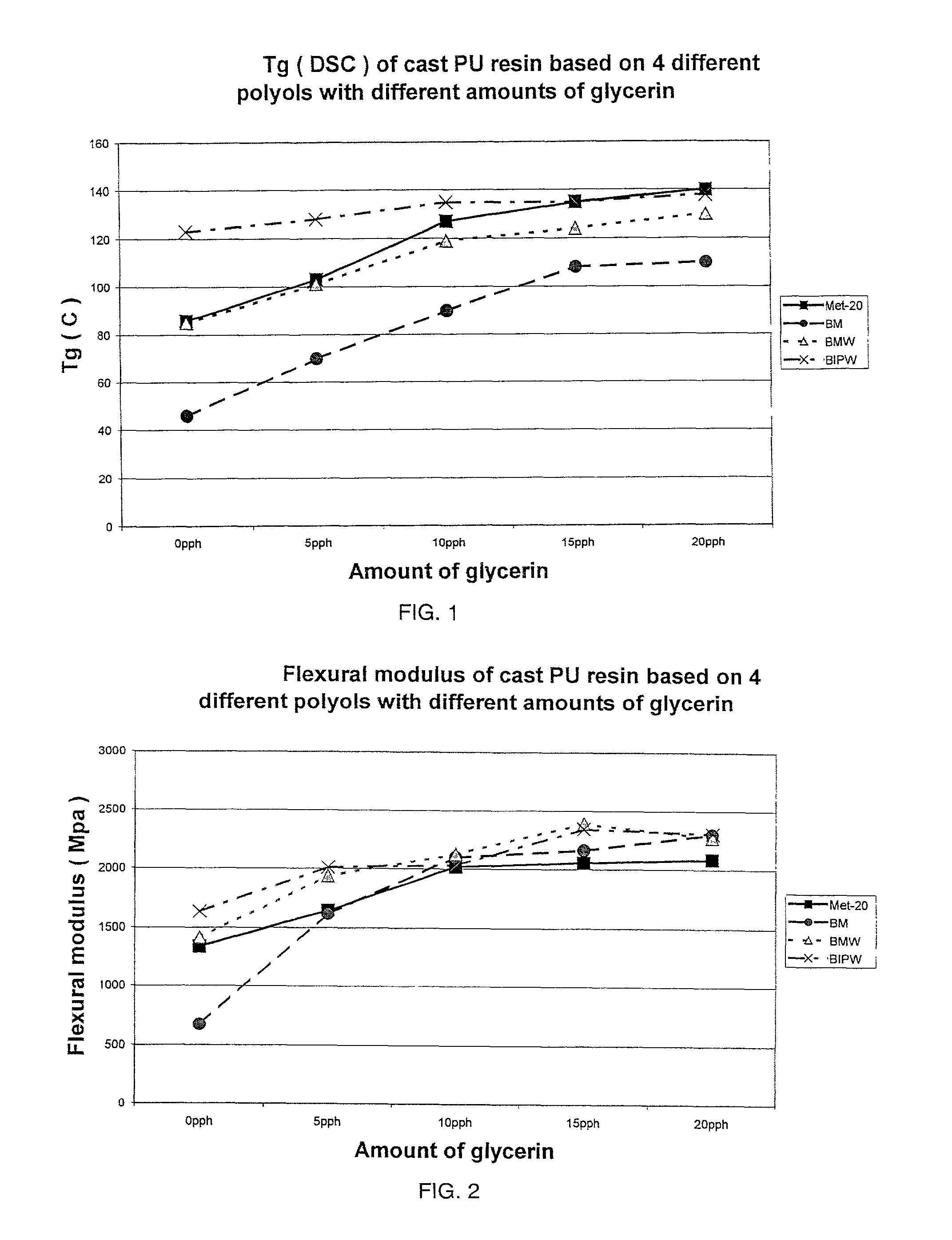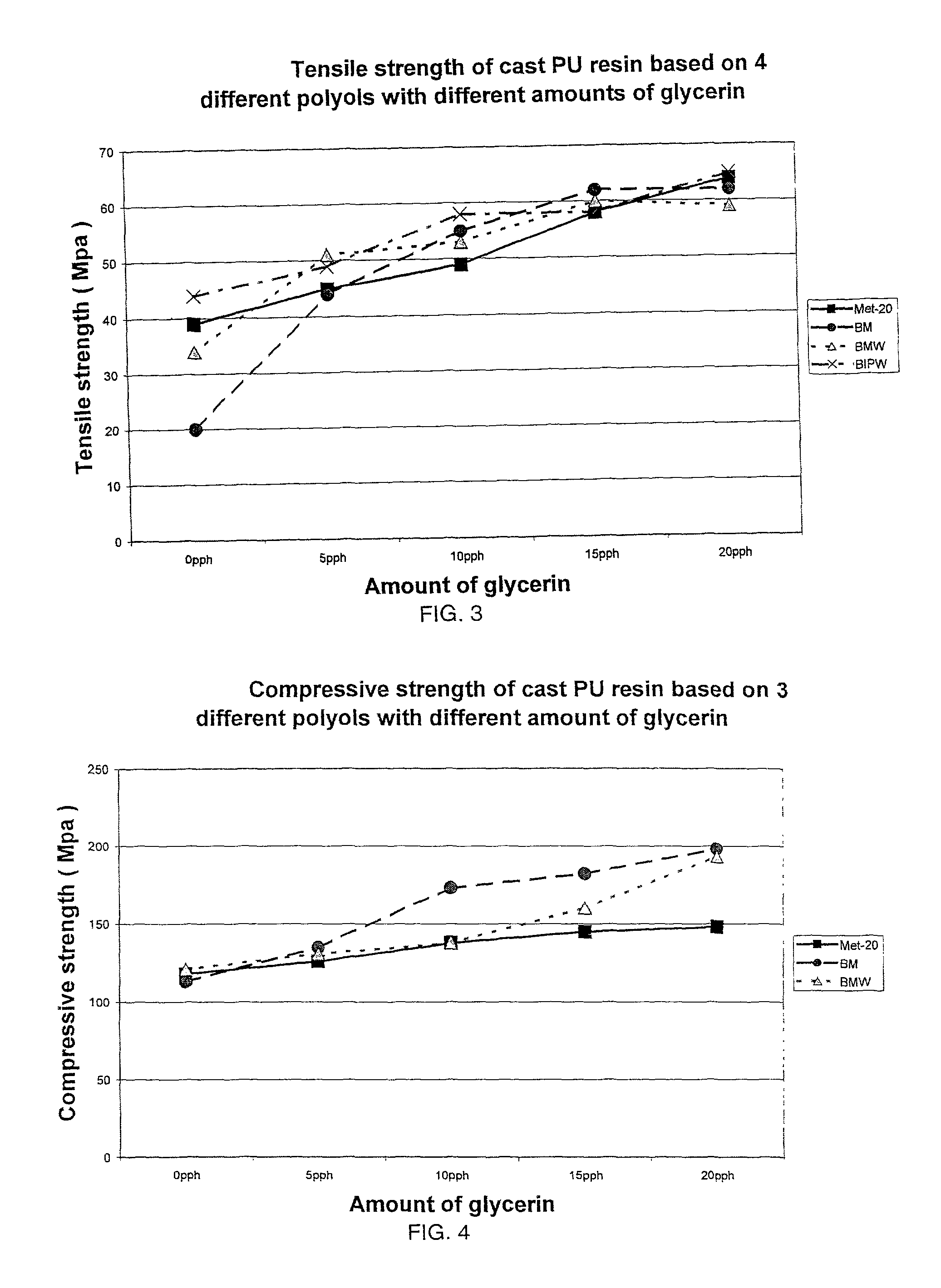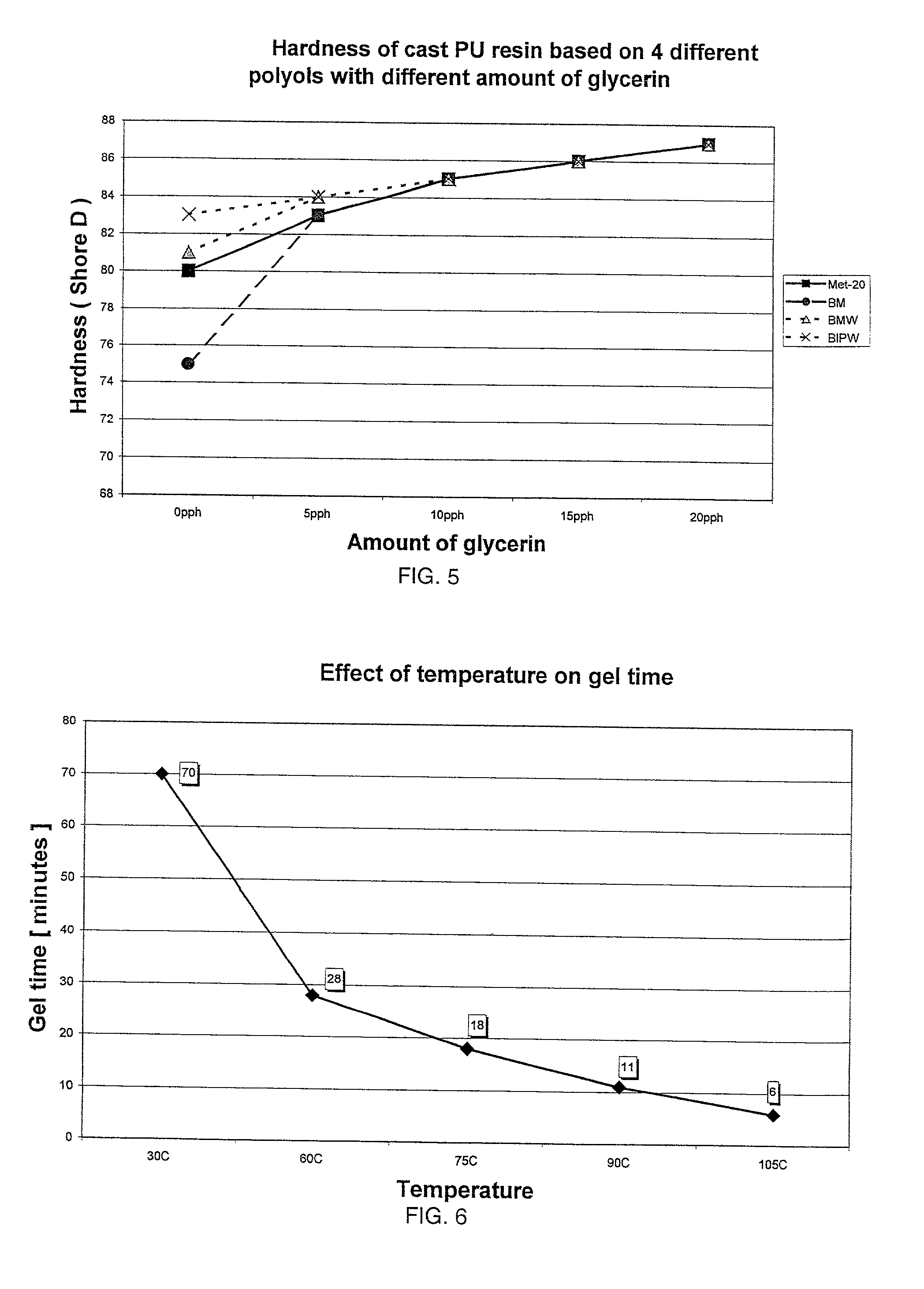Polymer concrete and method for preparation thereof
a technology of polymer concrete and polymer cement, which is applied in the direction of climate sustainability, solid waste management, construction, etc., can solve the problems of long curing time, the concrete made from conventional lime-containing cement degrades rapidly under normal use conditions, and the concrete made from conventional lime-containing cement is not well suited for use in structures, etc., to achieve the effect of high compressive strength, good splitting tensile strength and flexural strength
- Summary
- Abstract
- Description
- Claims
- Application Information
AI Technical Summary
Benefits of technology
Problems solved by technology
Method used
Image
Examples
example 1
Preparation of Soy Polyols
[0084]A variety of soy-polyols were produced by methods taught in U.S. Pat. No. 6,107,433 by varying the degree of hydroxylation. Such polyols are all suitable for use in forming the polyurethane matrix. For convenience, the resins are labeled MET-20, BM, BMW, and BIPW. Each polyol has different characteristics as shown in Table 1 below.
[0085]
TABLE 1General Properties Of The Soy PolyolsOH#1Epoxy Number2Viscosity3Soy Polyol(mg KOH / g)(%)(Pa · s)ColorMet-202080.0311.0light yellowBM1800.024.9light yellowBMW2070.02813.3light yellowBIPW2560.02826.0light yellow1Hydroxyl number - measures of the amount of reactive hydroxyl groups available for reaction. This value is determined by a wet analytical method according to ASTM D 4274-88 and reported as the number of mg of potassium hydroxide equivalent to the hydroxyl groups found in one gram of the sample.2Epoxy number measures epoxy content and is determined according to ASTM D 1652 using tiration with HBr.3Viscosity ...
example 2
Structural Properties of MET20 Polyol Resins
[0106]Eight cast polyurethane samples formed from soy-polyol Met-20 were prepared with different amounts of glycerin. The equivalent ratios of Met-20 and glycerin, expressed as parts per hundred by weight of the polyol, were:[0107]10 / 0 (0 pph glycerin, total OH#=208);[0108]9 / 1 (1.3 pph glycerin, total OH#=229);[0109]8 / 2 (2.8 pph glycerin, total OH#=252);[0110]7 / 3 (4.9 pph glycerin, total OH#=284);[0111]6 / 4 (7.6 pph glycerin, total OH#=322);[0112]5 / 5 (11.3 pph glycerin, total OH#=373);[0113]4 / 6 (17.1 pph glycerin, total OH#=444); and[0114]3 / 7 (26.5 pph glycerin, total OH#=548).
[0115]Aliquots of the eight MET20 polyol-glycerine mixtures described above were placed in a container and charged with PAPI® 2901 a polymeric methylene diphenyl diisocyanate (PMDI) from The Dow Chemical Company to provide an NCO / OH equivalent ratio of 1:1 in the resin mixture. The reagents were mixed to homogeneity for two to three minutes. Air bubbles were removed b...
example 3
Structural Properties of BM Polyol Resins
[0118]Eight cast resin samples were prepared using the soy-polyol BM that is described in Example 1, in combination with different amounts of glycerine. The equivalent ratios of BM polyol and glycerin were:[0119]10 / 0 (0 pph glycerin, total OH#=181);[0120]9 / 1 (1.1 pph glycerin, total OH#=199);[0121]8 / 2 (2.5 pph glycerin, total OH#=221);[0122]7 / 3 (4.2 pph glycerin, total OH#=248);[0123]6 / 4 (6.6 pph glycerin, total OH#=283);[0124]5 / 5 (9.9 pph glycerin, total OH#=329);[0125]4 / 6 (14.8 pph glycerin, total OH#=394); and[0126]3 / 7 (23.1 pph glycerin, total OH#=490).
[0127]Aliquots of the eight BM cast samples were mixed with an equivalent isocyanate moiety from PAPI® 2901 and hardened in an identical manner with respect to the cast resins of Example 2. The structural properties of each BM resin were determined according to the procedures described above and are shown in Table 3 below.
[0128]
TABLE 3Properties of Cast Resin Based On BM PolyolGlycerinTgTgF...
PUM
| Property | Measurement | Unit |
|---|---|---|
| diameter | aaaaa | aaaaa |
| diameter | aaaaa | aaaaa |
| length | aaaaa | aaaaa |
Abstract
Description
Claims
Application Information
 Login to View More
Login to View More - R&D
- Intellectual Property
- Life Sciences
- Materials
- Tech Scout
- Unparalleled Data Quality
- Higher Quality Content
- 60% Fewer Hallucinations
Browse by: Latest US Patents, China's latest patents, Technical Efficacy Thesaurus, Application Domain, Technology Topic, Popular Technical Reports.
© 2025 PatSnap. All rights reserved.Legal|Privacy policy|Modern Slavery Act Transparency Statement|Sitemap|About US| Contact US: help@patsnap.com



